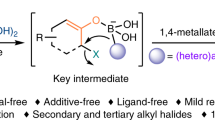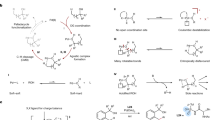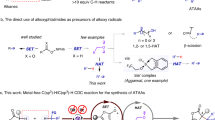Abstract
There have been numerous developments in C–H activation reactions in the past decade. Attracted by the ability to functionalize molecules directly at ostensibly unreactive C–H bonds, chemists have discovered reaction conditions that enable reactions of C(sp2)–H and C(sp3)–H bonds with a variety of coupling partners. Despite these advances, the development of suitable ligands that enable catalytic C(sp3)–H bond functionalization remains a significant challenge. Herein we report the discovery of a mono-N-protected amino acid ligand that enables Pd(II)-catalysed coupling of γ-C(sp3)–H bonds in triflyl-protected amines with arylboron reagents. Remarkably, no background reaction was observed in the absence of ligand. A variety of amine substrates and arylboron reagents were cross-coupled using this method. Arylation of optically active substrates derived from amino acids also provides a potential route for preparing non-proteinogenic amino acids.
This is a preview of subscription content, access via your institution
Access options
Subscribe to this journal
Receive 12 print issues and online access
$259.00 per year
only $21.58 per issue
Buy this article
- Purchase on Springer Link
- Instant access to full article PDF
Prices may be subject to local taxes which are calculated during checkout

Similar content being viewed by others
References
Engle, K. M., Mei, T-S., Wasa, M. & Yu, J-Q. Weak coordination as a powerful means for developing broadly useful C–H functionalization reactions. Acc. Chem. Res. 45, 788–802 (2012).
Lyons, T. W. & Sanford, M. S. Palladium-catalyzed ligand-directed C–H functionalization reactions. Chem. Rev. 110, 1147–1169 (2010).
Daugulis, O., Do, H-Q. & Shabashov, D. Palladium- and copper-catalyzed arylation of carbon–hydrogen bonds. Acc. Chem. Res. 42, 1074–1086 (2009).
Wencel-Delord, J., Dröge, T., Liu, F. & Glorius, F. Towards mild metal-catalyzed C–H bond activation. Chem. Soc. Rev. 40, 4740–4761 (2011).
Satoh, T. & Miura, M. Oxidative coupling of aromatic substrates with alkynes and alkenes under rhodium catalysis. Chem. Eur. J. 16, 11212–11222 (2010).
Kakiuchi, F. et al. Catalytic addition of aromatic carbon–hydrogen bonds to olefins with the aid of ruthenium complexes. Bull. Chem. Soc. Jpn 68, 62–83 (1995).
Colby, D. A., Bergman, R. G. & Ellman, J. A. Rhodium-catalyzed C–C bond formation via heteroatom-directed C–H bond activation. Chem. Rev. 110, 624–655 (2010).
Guimond, N., Gorelsky, S. I. & Fagnou, K. Rhodium(III)-catalyzed heterocycle synthesis using an internal oxidant: improved reactivity and mechanistic studies. J. Am. Chem. Soc. 133, 6449–6457 (2011).
Park, S. H., Kim, J. Y. & Chang, S. Rhodium-catalyzed selective olefination of arene esters via C–H bond activation. Org. Lett. 13, 2372–2375 (2011).
Ackermann, L. & Pospech, J. Ruthenium-catalyzed oxidative C–H bond alkenylations in water: expedient synthesis of annulated lactones. Org. Lett. 13, 4153–4155 (2011).
Shi, B-F., Maugel, N., Zhang, Y-H. & Yu, J-Q. PdII-catalyzed enantioselective activation of C(sp2)–H and C(sp3)–H bonds using monoprotected amino acids as chiral ligands. Angew. Chem. Int. Ed. 47, 4882–4886 (2008).
Wang, D-H., Engle, K. M., Shi, B-F. & Yu, J-Q. Ligand-enabled reactivity and selectivity in a synthetically versatile aryl C–H olefination. Science 327, 315–319 (2010).
Engle, K. M., Wang, D-H. & Yu, J-Q. Ligand-accelerated C–H activation reactions: evidence for a switch of mechanism. J. Am. Chem. Soc. 132, 14137–14151 (2010).
Wasa, M., Engle, K. M., Lin, D. W., Yoo, E. J. & Yu, J-Q. Pd(II)-catalyzed enantioselective C–H activation of cyclopropanes. J. Am. Chem. Soc. 133, 19598–19601 (2011).
Engle, K. M., Thuy-Boun, P. S., Dang, M. & Yu, J-Q. Ligand-accelerated cross-coupling of C(sp2)–H bonds with arylboron reagents. J. Am. Chem. Soc. 133, 18183–18193 (2011).
Baxter, R. D., Sale, D., Engle, K. M., Yu, J-Q. & Blackmond, D. G. Mechanistic rationalization of unusual kinetics in Pd-catalyzed C–H olefination, J. Am. Chem. Soc. 134, 4600–4606 (2012).
Wasa, M. et al. Ligand-enabled methylene C(sp3)–H bond activation with a Pd(II) catalyst. J. Am. Chem. Soc. 134, 18570–18572 (2012).
Kubota, A., Emmert, M. H. & Sanford, M. S. Pyridine ligands as promoters in PdII/0-catalyzed C–H olefination reactions. Org. Lett. 14, 1760–1763 (2012).
Chen, X., Goodhue, C. E. & Yu, J-Q. Palladium-catalyzed alkylation of sp2 and sp3 C–H bonds with methylboroxine and alkylboronic acids: two distinct C–H activation pathways. J. Am. Chem. Soc. 128, 12634–12635 (2006).
Baudoin, O. Transition metal-catalyzed arylation of unactivated C(sp3)–H bonds. Chem. Soc. Rev. 40, 4902–4911 (2011).
Ano, Y., Tobisu, M. & Chatani, N. Palladium-catalyzed direct ethynylation of C(sp3)–H bonds in aliphatic carboxylic acid derivatives. J. Am. Chem. Soc. 133, 12984–12986 (2011).
Chen, K., Hu, F., Zhang, S-Q. & Shi, B-F. Pd(II)-catalyzed alkylation of unactivated C(sp3)–H bonds: efficient synthesis of optically active unnatural α-amino acids. Chem. Sci. 4, 3906–3911 (2013).
Shang, R., Ilies, L., Matsumoto, A. & Nakamura, E. β-Arylation of carboxamides via iron-catalyzed C(sp3)−H bond activation. J. Am. Chem. Soc. 135, 6030–6032 (2013).
He, G. & Chen, G. A practical strategy for the structural diversification of aliphatic scaffolds through the palladium-catalyzed picolinamide-directed remote functionalization of unactivated C(sp3)–H bonds. Angew. Chem. Int. Ed. 50, 5192–5196 (2011).
Novak, P., Correa, A., Gallardo-Donaire, J. & Martin, R. Synergistic palladium-catalyzed C(sp3)–H activation/C(sp3)–O bond formation: a direct, step-economical route to benzolactones. Angew. Chem. Int. Ed. 50, 12236–12239 (2011).
Zaitsev, V. G., Shabashov, D. & Daugulis, O. Highly regioselective arylation of sp3 C–H bonds catalyzed by palladium acetate. J. Am. Chem. Soc. 127, 13154–13155 (2005).
Reddy, B. V. S., Reddy, L. R. & Corey, E. J. Novel acetoxylation and C–C coupling reactions at unactivated positions in α-amino acid derivatives. Org. Lett. 8, 3391–3394 (2006).
He, G., Zhao, Y., Zhang, S., Lu, C. & Chen, G. Highly efficient syntheses of azetidines, pyrrolidines, and indolines via palladium catalyzed intramolecular amination of C(sp3)–H and C(sp2)–H bonds at γ and δ positions. J. Am. Chem. Soc. 134, 3–6 (2012).
Rodríguez, N., Romero-Revilla, J. A., Fernández-Ibáñez, M. Á. & Carretero, J. C. Palladium-catalyzed N-(2-pyridyl)sulfonyl-directed C(sp3)–H γ-arylation of amino acid derivatives. Chem. Sci. 4, 175–179 (2013).
Chen, G. et al. Palladium-catalyzed picolinamide-directed alkylation of unactivated C(sp3)–H bonds with alkyl iodides. J. Am. Chem. Soc. 135, 2124–2127 (2013).
Liu, C. C. & Schultz, P. G. Adding new chemistries to the genetic code. Annu. Rev. Biochem. 79, 413–444 (2010).
Chen, X., Engle, K. M., Wang, D-H. & Yu, J-Q. Palladium(II)-catalyzed C–H activation/C–C cross-coupling reactions: versatility and practicality. Angew. Chem. Int. Ed. 48, 5094–5115 (2009).
Yamaguchi, K., Kondo, H., Yamaguchi, J. & Itami, K. Aromatic C–H coupling with hindered arylboronic acids by Pd/Fe dual catalysts. Chem. Sci. 4, 3753–3757 (2013).
Giri, R. et al. Palladium-catalyzed methylation and arylation of sp2 and sp3 C–H bonds in simple carboxylic acids. J. Am. Chem. Soc. 129, 3510–3511 (2007).
Wang, D-H., Wasa, M., Giri, R. & Yu, J-Q. Pd(II)-catalyzed cross-coupling of sp3 C–H bonds with sp2and sp3 boronic acids using air as the oxidant. J. Am. Chem. Soc. 130, 7190–7191 (2008).
Li, J-J., Mei, T-S. & Yu, J-Q. Synthesis of indolines and tetrahydroisoquinolines from arylethylamines by PdII-catalyzed C–H activation reactions. Angew. Chem. Int. Ed. 47, 6452–6455 (2008).
Mei, T-S., Wang, X. & Yu, J-Q. Pd(II)-catalyzed amination of C–H bonds using single-electron or two-electron oxidants. J. Am. Chem. Soc. 131, 10806–10807 (2009).
Wang, X., Mei, T-S. & Yu, J-Q. Versatile Pd(OTf)2·2H2O-catalyzed ortho-fluorination using NMP as a promoter. J. Am. Chem. Soc. 131, 7520–7521 (2009).
Chemler, S. R., Trauner, D. & Danishefsky, S. J. The B-alkyl Suzuki–Miyaura cross-coupling reaction: development, mechanistic study, and applications in natural product synthesis. Angew. Chem. Int. Ed. 40, 4544–4568 (2001).
Doucet, H. Suzuki–Miyaura cross-coupling reactions of alkylboronic acid derivatives or alkyltrifluoroborates with aryl, alkenyl or alkyl halides and triflates. Eur. J. Org. Chem. 2013–2030 (2008).
Molander, G. & Canturk, B. Organotrifluoroborates and monocoordinated palladium complexes as catalysts – a perfect combination for Suzuki–Miyaura coupling. Angew. Chem. Int. Ed. 48, 9240–9261 (2009).
Acknowledgements
This work was supported by The Scripps Research Institute and the National Institutes of Health (NIGMS, 2R01GM084019). K.S.L.C. thanks the Agency for Science, Technology and Research (A*STAR) Singapore for a predoctoral fellowship. M.W. thanks Bristol Myers Squibb for a predoctoral fellowship. M.M. thanks Astellas Pharma Inc. for a postdoctoral fellowship. This is The Scripps Research Institute (TSRI) manuscript no. 25049.
Author information
Authors and Affiliations
Contributions
K.S.L.C. conceived the study, principally performed the experiments and wrote the manuscript, M.W. helped with conceiving the study and preparing the manuscript, L.C. and B.N.L. performed experiments on coupling-partner scope, M.M. helped with identifying the deprotection strategy and J-Q.Y. provided overall supervision. All the authors discussed the results and commented on the manuscript.
Corresponding author
Ethics declarations
Competing interests
The authors declare no competing financial interests.
Supplementary information
Supplementary information
Supplementary information (PDF 2185 kb)
Rights and permissions
About this article
Cite this article
Chan, K., Wasa, M., Chu, L. et al. Ligand-enabled cross-coupling of C(sp3)–H bonds with arylboron reagents via Pd(II)/Pd(0) catalysis. Nature Chem 6, 146–150 (2014). https://doi.org/10.1038/nchem.1836
Received:
Accepted:
Published:
Issue Date:
DOI: https://doi.org/10.1038/nchem.1836
This article is cited by
-
A recyclable stereoauxiliary aminocatalyzed strategy for one-pot synthesis of indolizine-2-carbaldehydes
Communications Chemistry (2023)
-
Transition metal-catalysed directed C–H functionalization with nucleophiles
Nature Synthesis (2022)
-
Catalytic C(sp3)–H bond activation in tertiary alkylamines
Nature Chemistry (2020)
-
Teaching an old ligand new tricks
Nature Chemistry (2020)
-
Mechanism analysis of transient ligand-induced β-C–H arylation of α-methyl pentanone
Theoretical Chemistry Accounts (2020)



